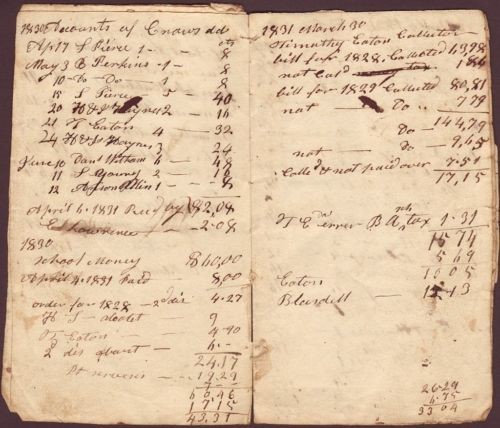East Pond Plantation Crow Ledger
This ledger belonged to an agent of East Pond Plantation, and provides insight into the lives of these settlers. The agent, possibly Timothy Eaton, kept notes on personal property for the plantation in a small (6 ¼” x 3 ¾”) notebook (see pages 6 & 7 below). This information was likely used later to determine town tax bills and state valuation. The notebook consists of eleven pages bound together with string but likely originally contained more pages. The agent kept notes on personal property of plantation residents, his fees, money due to the plantation from residents, animal bounties, school money, as well as other information about the plantation. For example “Postage of letter from Portland (cost) 12 ½ cents.”Page 6 also shows $43.31 was collected in 1830 for school money.
Dating back to the 1600s in North America, towns all along the Atlanticcoast offered bounties for dead crows to protect their crops. The governor of Maine approved on March 6, 1830, an act to encourage the destruction of crows. The act stated that “any person who may deliver to the Treasurer of any town or plantation, in this state, any Crow or Crows, dead or alive, shall be entitled to receive ... the sum of eight cents for each Crow...” The towns or plantations were to keep an account of the money they paid out; the state would then compensate the towns and plantations. The act was subsequently repealed on March 7, 1834. Pages 6 (Figure 3), 8, and 10 in the aforementioned East Pond Plantation ledger capture the bounties paid in the years 1830, 1832, and 1833. B. Perkins, T. Easton, and Dan Witham among others killed 26 crows for a bounty of $2.08 (Table 2). It is not clear if this captures the total crow count for 1830 or is only a partial list. This may not seem like a large sum of money, but compared to the going rate of 12 ½ cents per day for a man and oxen, it seemed a bargain.

